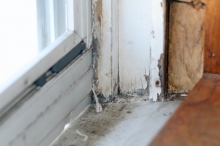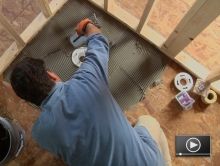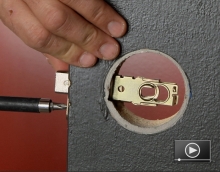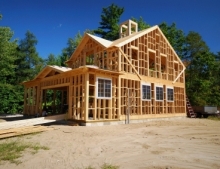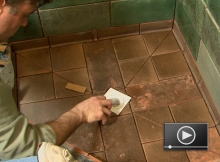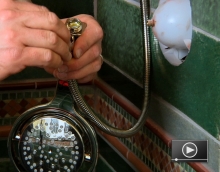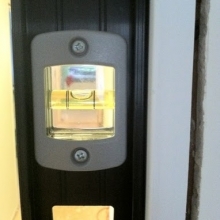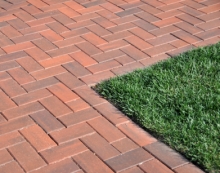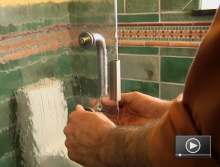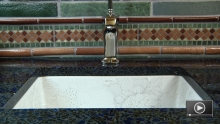If you're unfamiliar with the title of this article, or this important subject matter, don't feel bad – you're not alone. Confusion and a lack of awareness is the rule, rather than the exception, when it comes to the federal Environmental Protection Agency's (EPA’s) new Renovation, Repair, and Painting (RRP) rule, which totally redefines the way much of home remodeling is conducted. It centers on the control of dust from lead paint created from during RRP, not the elimination of the lead itself. The RRP rule is monumental – in its complexity, in the nature of the changes, and in the cost involved in compliance. Here's the EPA's explanation in a nutshell: “Under the rule, beginning April 22, 2010, contractors performing renovation, repair, and painting projects that disturb lead-based paint in homes, child care facilities, and schools built before 1978 must be certified and must follow specific work practices to prevent lead contamination.”
How to Install a Tileable Shower Base
Basic tiling skills can be very useful in many home improvement projects, but some tiling projects can prove daunting for even experienced DIY'ers. Installing tile for a custom shower is one of those projects. That has often meant leaving the job of custom showers to the pros – until now. Now there are new preformed bases on the market that allow a “do-it-yourselfer” with basic tile skills and tools to install a custom shower. Join the At Home channel host, Jeff Wilson, for a tutorial on installing a tileable shower basin in a custom bathroom.
How to Install Door Hardware
A homeowner might want to replace old door hardware for many reasons -- security, accessibility, style, or repair. Replacing door hardware only requires a simple set of skills and tools, but new door hardware can make a big difference in the way a door looks and works. Join the At Home channel’s host, Jeff Wilson, for a quick demonstration of how to install new door hardware.
Housewrap Boot Camp
Effective air sealing comes with workmanship. No matter what brand of housewrap you choose, you will be wasting your money unless you install it carefully. Getting the installation right is not hard, but it requires a basic understanding of how housewrap works. Detailed installation instructions can be found on manufacturers’ Web sites and often at the lumberyard or home center where housewrap is purchased.
How to Tile a Custom Bathroom
Ceramic tile is an ideal choice for walls and floors in any bathroom. It’s durable, impervious to water, and comes in an almost limitless selection of colors and styles. Tiling a custom bathroom with your own hands is a rewarding project for an experienced do-it-yourselfer. Join the At Home channel’s host, Jeff Wilson, as he offers guidance on installing wall and floor tile in the second installment of Buildipedia's custom bathroom series.
How to Install a Handheld Shower Fixture
One of the final steps in completing a custom shower project is selecting and installing the shower fixtures. While the task of selecting a shower fixture from the wide variety of styles can be challenging, installing the fixture is a simple job. With basic plumbing tools and skills, any do-it-yourselfer can install a shower fixture. Join the At Home channel’s host, Jeff Wilson, for a tutorial on installing a handheld shower fixture in the continuation of our custom bathroom series.
How to Replace a Prehung Interior Door
If your interior doors are severely stuck, rubbing, scratched, have holes, damaged beyond repair, or just don’t fit with your style, installing new prehung doors will sharpen the appearance of any room in your home and provide easy, daily operation. Installing a prehung door after removing an existing door isn't as difficult as you might think. With some patience and a little know-how, installing a prehung interior door is a project any DIY'er can do.
How to Install a Dry-Laid Paver Patio
Tired of eating at the picnic table on the lawn but not interested in maintaining a wood deck? Look to make a lasting impression in your backyard by installing a paver patio. Paver patios are aesthetically pleasing and are relatively low-maintenance. If you hire a contractor, you can expect to pay $15–$20 a square foot, depending on where you live and what type of paver you have selected. If you are able to set aside some time and are willing to perform the work on your own, you could save 40%–60% by doing it yourself. Let's get started!
How to Install a Glass Shower Enclosure
After tile, one of the most challenging jobs in building a custom shower is installing a glass shower enclosure. There are many options for shower enclosure systems, but to work properly the enclosure has to fit the shower precisely. This often necessitates hiring a professional to fabricate and install a system based on the specific dimensions of your custom shower. However, there are glass shower enclosure systems available that any savvy do-it-yourselfer can install with a few basic hand tools and a little know-how. Join the At Home channel’s host, Jeff Wilson, as he demonstrates how to complete a custom shower with a glass enclosure system.
How to Install a Bathroom Lavatory
Lavatory, or vanity, sinks are often the focal point of a bathroom. The bathroom sink is the most frequently used fixture in the room and comes in a nearly unlimited number of design options. Despite the wide variety of styles and components available, bathroom sinks all install in much the same way, and the installation of a bathroom sink is a project that just about any do-it-yourselfer can accomplish. Join the At Home channel’s host, Jeff Wilson, as he installs a lavatory cabinet, undermount sink, countertop, faucet, and drain to complete our custom bathroom series.
Home Automation
Will home automation become something that we can’t imagine living without? Jeff Wilson takes us on a tour of a design showroom that highlights some of the time- and energy-saving benefits of automation.
Home automation sounds a little intimidating. Just the mention makes me think of the USS Enterprise on Star Trek – seamless integration of controls for everything from lighting and sound to heating and air-conditioning to security and energy-efficiency. Oh, and don’t forget to set those phasers to stun.
Sod: Rolls of Sod vs. Plugs of Sod
Sod is a turfgrass that has been established by a sod farm. Purchased locally, types of sod may include rolls or plugs. Rolls of sod are purchased and delivered to your property on pallets. The rolls of sod are then laid over the soil, with strips tucked together and then rolled flat with a weighted roller. Plugs of sod are common with warm-season grasses. They are purchased by the bushel or torn from strips of sod. Plugs are planted in the soil in rows apart from one another, and over time they grow and fill in the barren areas.
